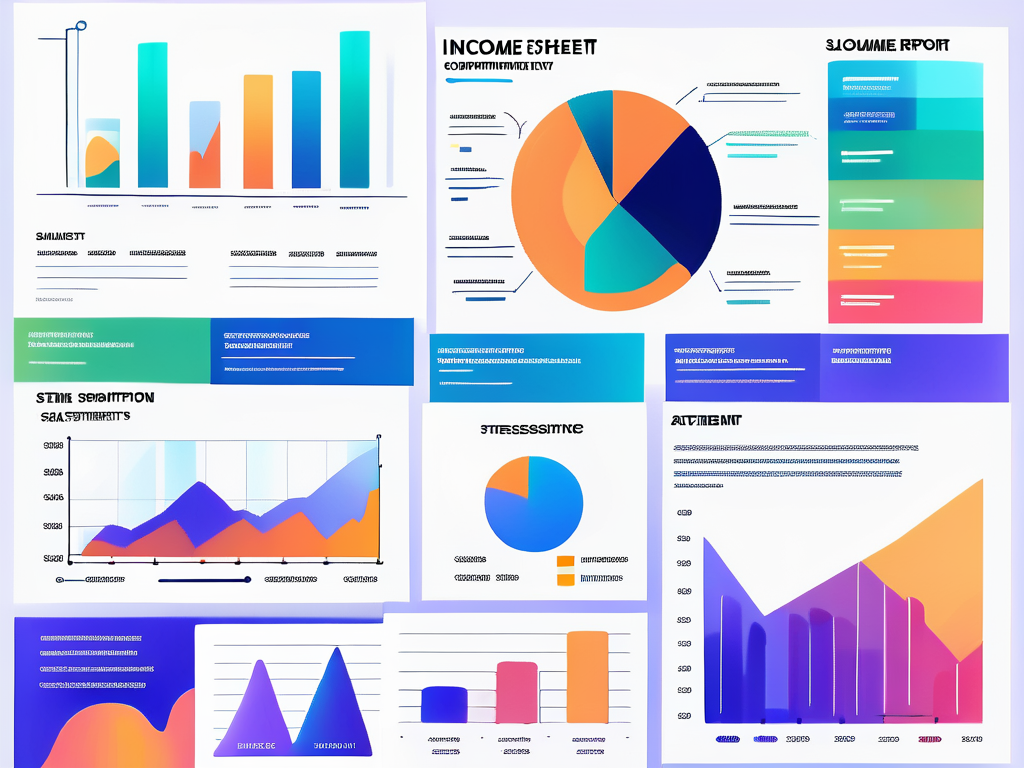How to Create Comprehensive Financial Reports for Nonprofits

Creating comprehensive financial reports is an essential task for nonprofit organizations, as these reports provide clarity not only to management but also to donors, stakeholders, and regulatory bodies. Financial reporting helps illustrate the health and sustainability of an organization, allowing for informed decision-making and fostering trust.
Understanding the Importance of Financial Reporting in Nonprofits
Financial reporting in nonprofits serves several crucial functions. These reports are not merely a reflection of an organization’s financial activities but also a tool for accountability and transparency. Nonprofits are tasked with managing funds responsibly, as they are typically funded by donations and grants designed to support their missions.
Moreover, comprehensive financial reports allow nonprofits to demonstrate their effectiveness and impact to stakeholders. They offer insights into how resources are being allocated and can highlight both successes and areas needing improvement. In many cases, transparency in financial matters strengthens relationships with donors and encourages continued support.
The Role of Transparency in Nonprofit Organizations
Transparency in financial reporting fosters trust and credibility. For a nonprofit to thrive, it is vital to keep donors informed about how their contributions are being utilized. This is particularly true given that many donors are motivated by a desire to see their funds making a real difference.
Transparency can also help prevent misunderstandings and potential conflicts. By openly sharing financial information, including how donations are spent and what projects are funded, nonprofits can provide a clear picture of their operations. This practice can lead to enhanced reputational strength and increased funding opportunities. Furthermore, in an era where social media and online platforms amplify voices, nonprofits that prioritize transparency are more likely to engage a broader audience, including potential volunteers and advocates who resonate with their mission.
Key Financial Indicators for Nonprofits
Key financial indicators serve as benchmarks for assessing the financial health of nonprofit organizations. Understanding these indicators can guide decision-making processes. Some essential indicators include:
- Program Efficiency Ratio: This measures how much of the total budget goes directly to programs versus administration and fundraising.
- Fundraising Efficiency: This indicates how effectively an organization raises funds by comparing fundraising expenses to the total contributions received.
- Liquidity Ratios: These assess the nonprofit’s ability to meet short-term obligations using its current assets.
Monitoring these indicators over time can reveal trends and help nonprofits adjust operations to improve financial outcomes. Additionally, organizations may also consider metrics such as the donor retention rate, which reflects how well they maintain relationships with existing donors. A high retention rate often correlates with effective communication and engagement strategies, further emphasizing the importance of financial reporting in cultivating long-term support. By analyzing these indicators in conjunction with qualitative data, nonprofits can create a holistic view of their performance and strategically plan for future growth and sustainability.
Components of a Comprehensive Financial Report
A comprehensive financial report is typically divided into several key components, each providing crucial insights into the organization’s financial status. Such reports generally include a balance sheet, income statement, and cash flow statement, each serving a unique purpose and presenting different financial aspects.
Balance Sheet Analysis
The balance sheet is a snapshot of the nonprofit’s assets, liabilities, and net assets at a specific point in time. Analyzing this report involves evaluating how resources are owned and what obligations exist. A strong balance sheet indicates that the organization possesses sufficient assets to cover liabilities, which is vital for long-term stability.
Nonprofits should regularly update their balance sheets and ensure that they comply with accounting standards, as accurate representation of net assets can impact funding and program delivery significantly. Additionally, it is essential for nonprofits to track changes in their balance sheets over time, as this can reveal trends in financial health. For instance, an increasing ratio of assets to liabilities can signal growth and stability, while a decreasing trend may raise red flags for stakeholders and potential donors. Regularly reviewing these figures can also help organizations identify areas for improvement, such as reducing debt or increasing reserves.
Income Statement Overview
The income statement, also known as the statement of activities, summarizes revenues and expenses over a specific period. This report highlights how much money the organization brought in (such as donations, grant funding, and earned income) and how much it spent on programs and operational costs.
By examining the income statement, nonprofits can assess the efficiency of their operations and identify trends in funding sources. A well-managed income statement allows organizations to make informed decisions about budget allocation, program expansions, or cost reductions. Moreover, analyzing the income statement in conjunction with the balance sheet can provide a more comprehensive view of financial performance. For example, if a nonprofit is experiencing a surplus in revenue but sees a decline in net assets, it may need to investigate whether expenses are being managed effectively or if investments are yielding expected returns. This holistic approach can empower nonprofits to strategize better for future sustainability.
Cash Flow Statement Breakdown
The cash flow statement provides critical insights into how cash is generated and utilized over time. Nonprofits often face unique challenges in managing cash flow due to the variability of donations and funding sources.
This statement is divided into three sections: operating activities, investing activities, and financing activities. Understanding these areas helps nonprofits forecast future cash needs and avoid potential shortfalls, ensuring that they can meet their financial commitments and sustain operations. Furthermore, a detailed cash flow analysis can help organizations identify seasonal trends in cash inflows and outflows, allowing them to plan more effectively for periods of low revenue. For instance, if a nonprofit typically receives a large portion of its funding at year-end, it might consider establishing a line of credit to bridge any gaps in cash flow during lean months. This proactive management of cash resources is crucial for maintaining operational continuity and supporting ongoing programs and services.
Steps to Create a Comprehensive Financial Report
Creating a comprehensive financial report involves a series of well-defined steps. Each step contributes to the report’s overall accuracy and effectiveness, ensuring that it meets the needs of both the organization and its stakeholders.
Gathering Relevant Financial Data
The first step in creating a financial report is to gather relevant data from various sources. This could include accounting software, bank statements, donation records, and expense reports. Accurate and comprehensive data collection is essential, as it forms the foundation for analysis and reporting.
In this stage, it’s crucial to involve key personnel who understand both financial and operational aspects of the nonprofit. Collaboration can help ensure that no critical information is overlooked. Engaging team members from different departments not only enriches the data pool but also fosters a sense of ownership and accountability among staff, which can lead to more accurate reporting and a stronger commitment to the organization’s financial health.
Analyzing and Interpreting Financial Information
Once data is collected, the next step is analyzing the financial information. This involves examining trends, comparing various financial indicators, and assessing how effectively the organization is operating.
Interpretation of this analysis should highlight key areas for improvement as well as strong performance metrics. A thorough understanding of the data allows leaders to make informed decisions about future funding and operational strategies. Furthermore, it can be beneficial to benchmark the organization’s performance against industry standards or similar organizations. This comparative analysis can reveal insights into operational efficiencies and areas where the organization may be lagging, providing a clearer picture of its financial standing in the broader context.
Preparing and Presenting the Financial Report
The final step involves preparing the report itself. This should be structured in a way that is clear and accessible to the audience. Utilizing visuals such as graphs and charts can enhance understanding and retention of the information presented.
Additionally, when presenting the financial report to stakeholders, it is important to provide context and insights, explaining the implications of the data on the organization’s mission and future direction. Tailoring the presentation to the audience’s level of financial literacy can also be beneficial; for instance, using simplified language for board members who may not have a financial background while providing more detailed analysis for finance committee members. Engaging storytelling techniques can further captivate the audience, making the financial data not just numbers on a page, but a narrative that reflects the organization’s journey and aspirations.
Best Practices for Nonprofit Financial Reporting
Adhering to best practices in financial reporting is vital for nonprofits seeking to maintain transparency and enhance their credibility. Implementing these practices can lead to a more efficient financial management process overall.
Regular Financial Review and Monitoring
Conducting regular financial reviews allows nonprofits to keep tabs on their budgets, expenditures, and overall financial health. This practice not only helps in identifying discrepancies early but also promotes accountability within the organization.
Additionally, regular monitoring facilitates timely adjustments to financial strategies, ensuring alignment with the nonprofit’s goals and mission.
Utilizing Financial Management Software
In today’s digital age, leveraging financial management software is increasingly beneficial for nonprofits. These tools can streamline data collection, reporting, and analysis processes, saving time and reducing errors.
Such software often includes features for tracking donations, managing expenditures, and generating insightful reports, thus empowering organizations to focus more on their mission rather than administrative tasks.
Ensuring Compliance with Nonprofit Financial Reporting Standards
Compliance with financial reporting standards is a paramount concern for nonprofits. Adherence to guidelines ensures that reports are not only accurate but also trustworthy. Organizations should stay updated on accounting regulations specific to the nonprofit sector to avoid legal pitfalls.
Regular training for staff on compliance matters can help embed this understanding throughout the organization, reinforcing the integrity of financial reporting practices.
In conclusion, comprehensive financial reporting is indispensable for nonprofit organizations. By understanding the importance of transparency, leveraging key financial indicators, and adhering to best practices, nonprofits can effectively navigate the complexities of funding and financial management, ensuring long-term sustainability and growth.
As you strive to enhance your nonprofit’s financial reporting and transparency, remember that a robust digital presence is equally crucial for sustainable growth. BlueWing is dedicated to helping organizations like yours maximize the impact of paid social media and search campaigns, including the Google Ad Grants program. Our expertise in managing paid media for nonprofits ensures that your message reaches the right audience, effectively and efficiently. Ready to amplify your impact and build a growth engine for your mission? Contact us today to learn how we can support your goals.





